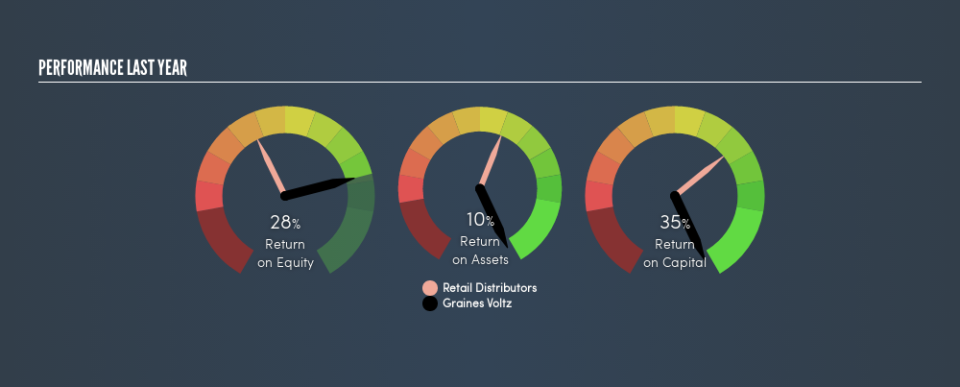What Can We Make Of Graines Voltz’s (EPA:GRVO) High Return On Capital?

Want to participate in a short research study? Help shape the future of investing tools and you could win a $250 gift card!
Today we are going to look at Graines Voltz (EPA:GRVO) to see whether it might be an attractive investment prospect. Specifically, we'll consider its Return On Capital Employed (ROCE), since that will give us an insight into how efficiently the business can generate profits from the capital it requires.
First of all, we'll work out how to calculate ROCE. Then we'll compare its ROCE to similar companies. Then we'll determine how its current liabilities are affecting its ROCE.
Understanding Return On Capital Employed (ROCE)
ROCE is a metric for evaluating how much pre-tax income (in percentage terms) a company earns on the capital invested in its business. In general, businesses with a higher ROCE are usually better quality. Ultimately, it is a useful but imperfect metric. Renowned investment researcher Michael Mauboussin has suggested that a high ROCE can indicate that 'one dollar invested in the company generates value of more than one dollar'.
So, How Do We Calculate ROCE?
The formula for calculating the return on capital employed is:
Return on Capital Employed = Earnings Before Interest and Tax (EBIT) ÷ (Total Assets - Current Liabilities)
Or for Graines Voltz:
0.35 = €15m ÷ (€101m - €59m) (Based on the trailing twelve months to March 2019.)
So, Graines Voltz has an ROCE of 35%.
See our latest analysis for Graines Voltz
Is Graines Voltz's ROCE Good?
ROCE is commonly used for comparing the performance of similar businesses. Graines Voltz's ROCE appears to be substantially greater than the 12% average in the Retail Distributors industry. We consider this a positive sign, because it suggests it uses capital more efficiently than similar companies. Setting aside the comparison to its industry for a moment, Graines Voltz's ROCE in absolute terms currently looks quite high.
In our analysis, Graines Voltz's ROCE appears to be 35%, compared to 3 years ago, when its ROCE was 18%. This makes us think the business might be improving. The image below shows how Graines Voltz's ROCE compares to its industry, and you can click it to see more detail on its past growth.
Remember that this metric is backwards looking - it shows what has happened in the past, and does not accurately predict the future. ROCE can be misleading for companies in cyclical industries, with returns looking impressive during the boom times, but very weak during the busts. This is because ROCE only looks at one year, instead of considering returns across a whole cycle. You can check if Graines Voltz has cyclical profits by looking at this free graph of past earnings, revenue and cash flow.
How Graines Voltz's Current Liabilities Impact Its ROCE
Short term (or current) liabilities, are things like supplier invoices, overdrafts, or tax bills that need to be paid within 12 months. Due to the way the ROCE equation works, having large bills due in the near term can make it look as though a company has less capital employed, and thus a higher ROCE than usual. To counter this, investors can check if a company has high current liabilities relative to total assets.
Graines Voltz has total liabilities of €59m and total assets of €101m. Therefore its current liabilities are equivalent to approximately 58% of its total assets. While a high level of current liabilities boosts its ROCE, Graines Voltz's returns are still very good.
The Bottom Line On Graines Voltz's ROCE
In my book, this business could be worthy of further research. Graines Voltz looks strong on this analysis, but there are plenty of other companies that could be a good opportunity . Here is a free list of companies growing earnings rapidly.
If you like to buy stocks alongside management, then you might just love this free list of companies. (Hint: insiders have been buying them).
We aim to bring you long-term focused research analysis driven by fundamental data. Note that our analysis may not factor in the latest price-sensitive company announcements or qualitative material.
If you spot an error that warrants correction, please contact the editor at editorial-team@simplywallst.com. This article by Simply Wall St is general in nature. It does not constitute a recommendation to buy or sell any stock, and does not take account of your objectives, or your financial situation. Simply Wall St has no position in the stocks mentioned. Thank you for reading.

